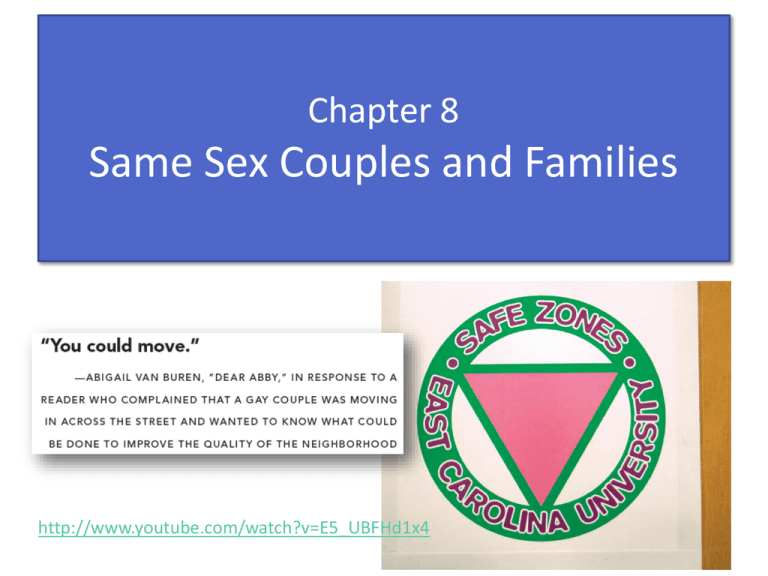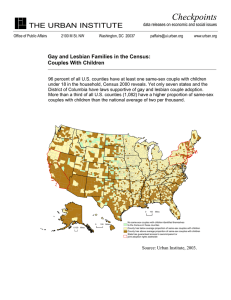
Chapter 8
Same Sex Couples and Families
http://www.youtube.com/watch?v=E5_UBFHd1x4
Same Sex Couples and Families
• Is marriage between one-man and onewoman a cultural universal?
• What drives our attitudes toward same sex
marriage and relationships?
– Religion?
– School?
– Government?
– Mass Media?
– http://www.youtube.com/watch?v=L9l52J36ht8
Gay, Lesbian, Bisexual and MixedOrientation Relationships
• Gay and lesbian couples
tend to be more similar
to, than different from
heterosexual couples.
• Relationship satisfaction
is related to having equal
power and control, being
emotionally expressive,
perceiving many
attractions to the
relationship, and
commitment.
Relationships
• Heterosexual couples enjoy social and
institutional support for their relationships.
• Gay male and lesbian couples must cope with
stress created by antigay prejudice and
discrimination.
– Negative self image
– Low self-esteem
• Yet, Relationship satisfaction is reported at
about equal to that of heterosexual couples
Relationships
• Gay and lesbian couples tend to
disagree about the same issues
that heterosexual couples argue
about.
– The political experience
• Same-sex couples tend to
maintain a more positive tone
throughout an argument.
– Losing a partner may also mean
losing networks
• Most gay males and females
prefer monogamous, long-term
relationships.
• Gay men report greater interest in
casual sex than do heterosexual
men.
Relationships
• The majority of bisexual women and men tend
toward primary relationships with the other
sex.
• Mixed-orientation couples are those in which
one partner is heterosexual and the other
partner is gay, lesbian, or bisexual.
Legal Recognition and Support of
Same-Sex Couples and Families
• Lawrence v. Texas: a 2003 U.S. Supreme Court
decision that invalidated state laws that
criminalized sodomy—oral and anal sexual
acts
• Prior to that ruling sodomy was illegal in 13
states.
Legal Recognition
• U.S. states and countries throughout the
world recognize same-sex couples in a variety
of ways.
– Civil union
– Domestic partnership:
Legal Recognition
• There is no federal recognition of same-sex
couples in the United States.
• States grant rights and responsibilities.
• Most of the Fortune 500 companies provide
health benefits to same-sex couples.
Legal Recognition
• As of today, 14 states and the District of Columbia
offered marriage licenses to same-sex couples.
• Just over half of Americans oppose gay marriage.
• Defense of Marriage Act: legislation passed by
Congress denying federal recognition of
homosexual marriage and allowing states to
ignore same-sex marriages licensed by other
states
• (DOMA was struck down by the supreme court in 2013),
However….
Legal Recognition
Arguments in favor of same-sex marriage:
• Violation of civil rights
• Denial of rights and benefits accorded to other
spouses
• Promoting relationship stability
• Beneficial to children
• Religious teachings promoting fairness and
equality
Legal Recognition
Arguments against same-sex marriage:
• View of homosexuality as immoral
• Damaging heterosexual marriage
• Subverting stability of heterosexual families
• Religious views
LGBT Parenting
• One third of lesbians and one fifth of gay men
are parents.
• Over 10 million children are being reared by
gay parents.
• Gays become parents through prior
heterosexual relationships, assisted
reproductive technology, or adoption.
LGBT Parenting
• Research concludes that children of gay and
lesbian parents are just as likely to flourish as
are children of heterosexual parents.
• Children benefit from having two parents.
LGBT Parenting
• Lesbian and gay parents are often
discriminated against in child custody,
visitation, adoption, and foster care.
• Second-parent adoption: a legal procedure
that allows individuals to adopt their partner’s
biological or adoptive child without
terminating the first parent’s legal status as a
parent
Chapter Summary
• Gay and lesbian parents often face prejudice
and discrimination but evidence suggests their
children are just as likely as others to flourish.
• Antigay bias has negative consequences for
heterosexuals.
Chapter Review
1. What are the different terms that refer to the
diverse forms of sexual orientation?
2. How prevalent is homosexuality and
bisexuality?
3. How do beliefs about sexual orientation
affect attitudes?
4. What is heterosexism?
5. What are LGBT relationships like?
Chapter Review
6. What are the legal issues regarding same-sex
couples?
7. What are the LGBT parents issues?
8. How are heterosexuals negatively affected by
antigay bias?

![-----Original Message----- From: Elizabeth H. Maury, Ph.D. [ ]](http://s2.studylib.net/store/data/015587840_1-99e1c0d77ec14fce523cbff8ea4fb89d-300x300.png)
![-----Original Message----- From: Barbara Weber [ ]](http://s2.studylib.net/store/data/015586600_1-e8c9622821d587c53ebbb8dcce2954d8-300x300.png)

![-----Original Message----- From: Rebecca Snarski [ ]](http://s2.studylib.net/store/data/015587796_1-276659ecf7bb177fecf464a302d19439-300x300.png)

